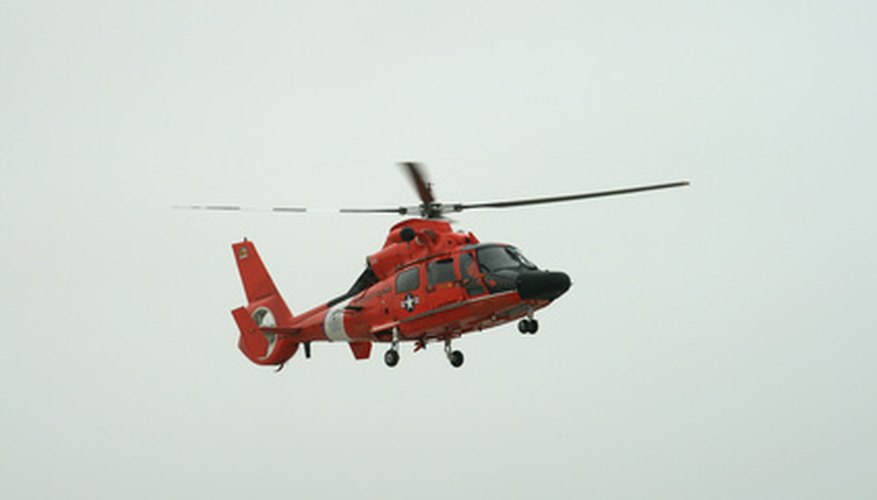If it's your aspiration to one day become a United States Coast Guard rescue swimmer, be prepared for long and gruelling training. According to the U.S. Department of Defense, the rescue swimmers division is made up of only 300 people. Candidates for the rescue swimming team face the same challenges as any potential Army Ranger, Navy SEAL and Air Force Pararescueman. The Department of Defense supplied a 2004 interview with Chief Petty Officer Thor Wentz, who assists in running the rescue swimmer's school.
Duties
The elite of the elite of Coast Guards divisions, rescue swimmers are those who free-fall or lower into turbulent water to rescue people. The water bodies can include open-ocean, river rescue or flooded areas. They also assist in natural disasters such as hurricanes. CNN interviewed Petty Officer John Rice, United States Coast Guard Rescue Swimmer, about the duties during and after Hurricane Ike. Before the storm made landfall, according to Rice, they helped evacuate civilians to safer grounds. Afterwards, a search and rescue mission ensued. The rescue swimmers flew over the flooded areas in a helicopter searching for people on rooftops or trapped in flood waters. When someone was found, a rescue swimmer would lower from the helicopter by a cable to the victim, attach the victim to the cable and then lift him back up into the aircraft.
- The elite of the elite of Coast Guards divisions, rescue swimmers are those who free-fall or lower into turbulent water to rescue people.
Chances of Becoming a Rescue Swimmer
According to Chief Petty Officer Thor Wentz, the rescue training school has the highest dropout rate of any special unit school in the military. About 75 candidates are accepted each year and less that half make it through. Wentz says most students don't even make it into the pool before quitting. Others disappear after a few days. In 2004, an entire class of 12 was dismissed in the first week.
- According to Chief Petty Officer Thor Wentz, the rescue training school has the highest dropout rate of any special unit school in the military.
- Wentz says most students don't even make it into the pool before quitting.
First Phase of Training
The first course a student will go through is airmen training. It's a four-month course that prepares the candidates for the rescue swimming course. The airmen phase gets the candidate used to life at a Coast Guard Air Station and, Wentz said, "to see if they have what it takes to become a rescue swimmer." This phase is a test to see if the candidate has the mental toughness to proceed in the training.
- The first course a student will go through is airmen training.
- It's a four-month course that prepares the candidates for the rescue swimming course.
Rescue Swimmer Training
Once a candidate starts training, he learns different procedures for water deployment; ways to approach, carry and release a victim; how to release equipment for other branches of the military; and how to detangle parachutes and backpacks. A candidate also will go through a four-week emergency medical course to teach him how to administer basic life support. Also swim training begins. Wentz said here you will find that the people who believe they are comfortable in the water are really not. Some panic and realise they are not cut out to be a rescue swimmer. The first six weeks are gruelling both mentally and physically.
- Once a candidate starts training, he learns different procedures for water deployment; ways to approach, carry and release a victim; how to release equipment for other branches of the military; and how to detangle parachutes and backpacks.
Women as Rescue Swimmers
A majority of rescue swimmers are men. However the division does welcome women. According to Wentz, as of 2004, only three of the 300 qualified rescue swimmers are women.
Fitness Standards
Stew Smith, former Navy SEAL and certified Strength and Conditioning Specialist, listed the fitness requirements for rescue swimming training, according to the rescue swimmer syllabus. Candidates must be able to stay in the heavy seas for 30 minutes and be able to perform duties while in 10- to 20-foot waves. A monthly physical training test will be given. This includes push-ups, sit-ups, 12-minute crawl swim, swimming underwater for 25 yards and a 200-yard buddy tow.
- Stew Smith, former Navy SEAL and certified Strength and Conditioning Specialist, listed the fitness requirements for rescue swimming training, according to the rescue swimmer syllabus.
